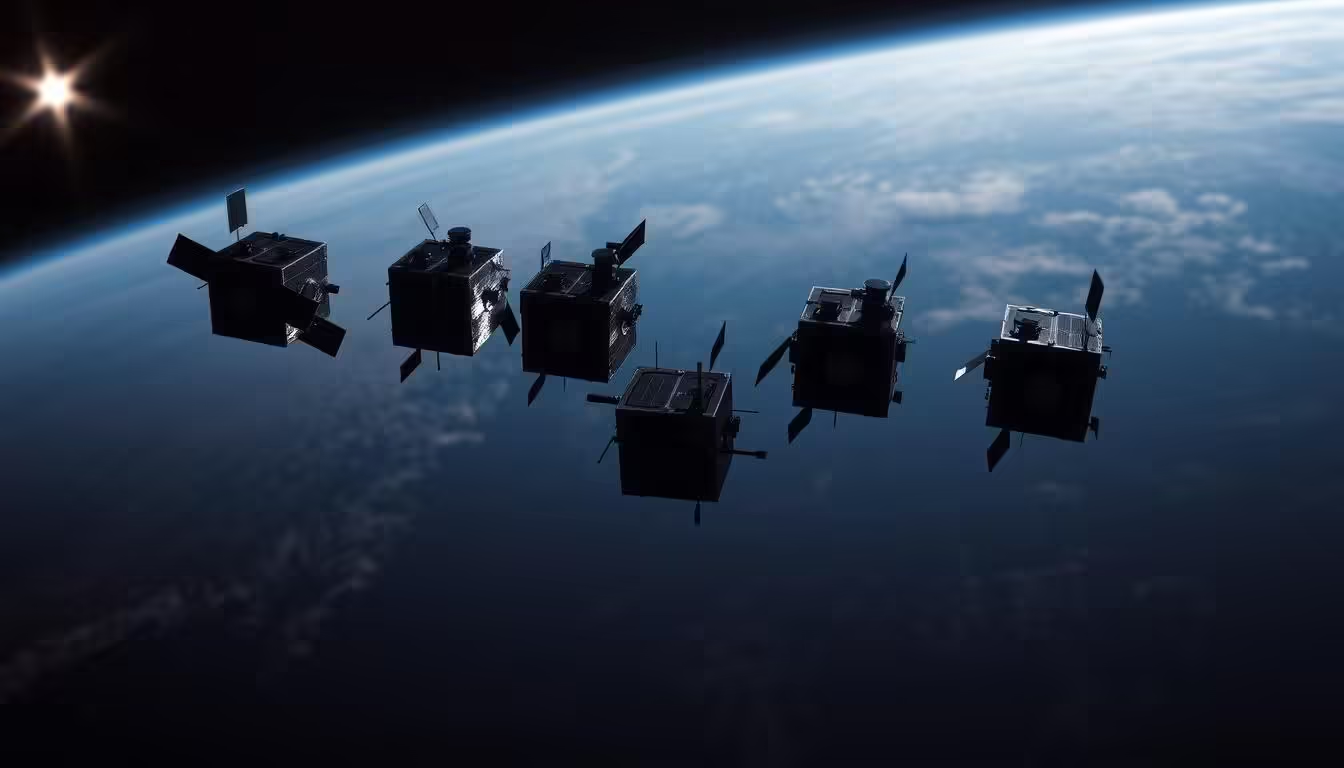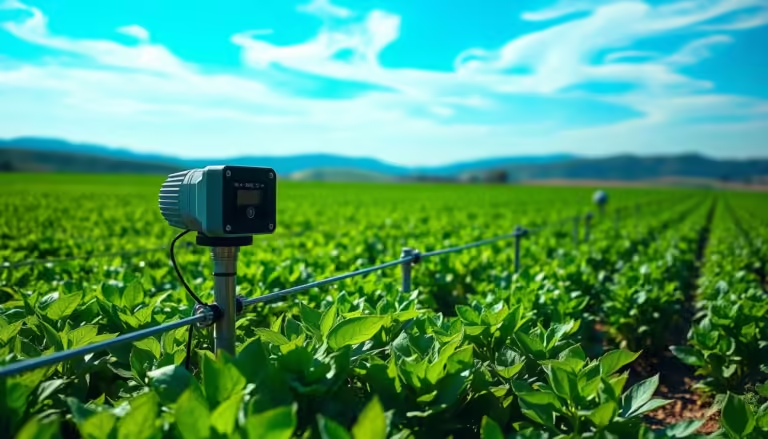The concept of capturing images of Earth from space is no longer the stuff of science fiction. Thanks to advancements in satellite technology, tiny satellites known as CubeSats are now able to photograph our planet daily.

These CubeSats, often no larger than a shoebox, are revolutionizing the way we observe Earth from space. By capturing daily images, they provide invaluable data for various applications, from monitoring weather patterns to tracking environmental shifts.
Key Takeaways
- CubeSats are tiny satellites that capture daily images of Earth.
- They are revolutionizing Earth observation from space.
- CubeSats provide invaluable data for various applications.
- Their small size makes them an efficient and cost-effective solution.
- Daily images from CubeSats help in monitoring weather and environmental changes.
The Rise of Cube Satellites: Tiny Technology with a Massive Impact
In recent years, the space industry has witnessed the rise of CubeSats, tiny satellites that pack a big punch. These miniaturized satellites have been transforming the way we approach space exploration and research.

What Are Cube Satellites?
CubeSats are a class of miniaturized satellites that follow standardized dimensions, typically measuring 10x10x10 cm. They are designed to be compact, efficient, and cost-effective, making them an attractive option for a wide range of space-related applications. Some key characteristics of CubeSats include:
- Standardized size and shape
- Low development and launch costs
- Flexibility in mission design and objectives
This standardization has enabled the development of a robust ecosystem around CubeSats, including launch services and ground support systems.
From Academic Projects to Space Revolution
Initially, CubeSats were used primarily in academic settings for educational purposes and simple technology demonstrations. However, their potential soon became apparent, and they began to be adopted for more complex missions, including Earth observation, technology testing, and scientific research. The CubeSat format has democratized access to space, allowing:
- Universities and research institutions to conduct space research
- Small companies and startups to enter the space industry
- Countries with limited space programs to participate in space exploration
This shift has led to a proliferation of CubeSats, with numerous constellations now in orbit around Earth, providing unprecedented coverage and data.
The Evolution of Earth Observation: From Massive Satellites to Shoebox-Sized CubeSats
The evolution of Earth observation technology has been marked by a significant shift from large, expensive satellites to smaller, more cost-effective CubeSats. This transition has opened up new possibilities for monitoring our planet.
Traditional Earth Observation Satellites
Traditional Earth observation satellites are often large and complex, requiring significant financial investment and technological expertise. These satellites, while capable of providing high-resolution imagery, are limited by their size and cost. For instance, a single traditional satellite can cost hundreds of millions of dollars to launch and maintain.
| Characteristics | Traditional Satellites | CubeSats |
|---|---|---|
| Size | Large | Shoebox-sized |
| Cost | Expensive (hundreds of millions) | Cost-effective (thousands to millions) |
| Launch Frequency | Less frequent | More frequent |
The CubeSat Disruption
The emergence of CubeSats has disrupted the traditional Earth observation paradigm. These small satellites are not only more affordable but also enable more frequent launches and deployments. As a result, CubeSats have democratized access to Earth observation data, benefiting various fields such as environmental monitoring, disaster response, and agricultural management.

CubeSats have also facilitated the creation of large constellations of satellites, providing daily or near-daily coverage of the Earth’s surface. This capability is revolutionizing the way we monitor and understand our planet.
How CubeSats Capture Daily Images of Earth
With their compact design and cutting-edge technology, CubeSats are revolutionizing the way we observe Earth, providing daily snapshots of our planet. This capability is made possible by a combination of advanced orbital mechanics, sophisticated imaging technology, and efficient data transmission systems.
Orbital Mechanics and Coverage
CubeSats achieve daily coverage of Earth through precise orbital mechanics. By positioning these small satellites in sun-synchronous orbits, they can pass over the same spot on Earth at the same local time each day, ensuring consistent lighting conditions for imaging. This orbit allows for the collection of images that are comparable over time, which is crucial for monitoring changes on Earth’s surface.
The orbital mechanics involved are complex, requiring a deep understanding of how to maintain a stable orbit while minimizing collisions with other satellites or space debris. The strategic positioning of CubeSats enables them to cover vast areas of Earth’s surface, capturing images that are vital for various applications, including environmental monitoring and agricultural assessment.
Imaging Technology in Miniature
Despite their small size, CubeSats are equipped with advanced imaging technology that allows them to capture high-resolution images. These imaging systems are designed to be highly sensitive and capable of resolving details on Earth’s surface with remarkable clarity. The technology includes high-resolution cameras and sophisticated sensors that can detect a wide range of wavelengths, from visible light to infrared.

Data Transmission and Processing
Once CubeSats capture images of Earth, they transmit this data back to Earth stations. The data transmission process involves converting the captured images into digital signals, which are then transmitted via radio waves. Upon reception, the data is processed to correct for any distortions or errors that occurred during transmission. The processed images are then made available for analysis, providing valuable insights into Earth’s condition and changes over time.
The efficiency of data transmission and processing is critical to the success of CubeSats. Advances in compression algorithms and transmission protocols have significantly improved the ability to transmit large amounts of data from space to Earth, enabling the widespread use of CubeSats for Earth observation.
Planet Labs and Other Pioneers: Companies Photographing Earth Daily
Planet Labs is at the forefront of daily Earth observation, utilizing their Dove Constellation to capture our planet’s changes. This innovative approach to Earth imaging has opened up new possibilities for understanding our planet’s dynamics.
The “Dove” Constellation
The Dove Constellation is a fleet of CubeSats operated by Planet Labs, designed to image the Earth’s surface daily. This constellation is a marvel of modern technology, with numerous CubeSats working in tandem to achieve comprehensive coverage of our planet.
Creating a Photographic Time-Lapse of Our Planet
By capturing daily images of Earth, the Dove Constellation enables the creation of a photographic time-lapse of our planet. This time-lapse is invaluable for observing changes in the environment, tracking natural disasters, and understanding Earth’s dynamics.
The data collected by Planet Labs and other pioneers in CubeSat technology is not only fascinating but also crucial for scientific research and environmental monitoring.
Earth Through New Eyes: What Daily Satellite Images Reveal About Our Planet
The advent of daily satellite images from CubeSats has revolutionized our understanding of Earth’s dynamics. This technological leap forward allows us to observe our planet in unprecedented detail, revealing changes, patterns, and phenomena that were previously unnoticed.

Seeing Change in Real-Time
One of the most significant advantages of daily satellite imagery is the ability to monitor changes in real-time. This capability is crucial for tracking environmental shifts, such as deforestation, glacier melting, and sea-level rise. For instance, Planet Labs’ “Dove” constellation provides daily images that help scientists and researchers observe these changes with greater precision.
The real-time data enables more effective management of natural resources and quicker responses to environmental disasters. It also facilitates the monitoring of seasonal changes and patterns, offering insights into the health of our planet.
The Beauty and Fragility of Earth from Above
Daily satellite images not only provide valuable data but also offer a unique perspective on the beauty and fragility of our planet. Images captured by CubeSats reveal the intricate patterns of our environment, from the sprawling networks of rivers to the vibrant colors of phytoplankton blooms in the oceans.
These images serve as a poignant reminder of Earth’s vulnerability and the need for sustainable practices. By appreciating the beauty of our planet from space, we are inspired to protect it.
Unexpected Discoveries from Daily Imagery
The daily imagery from CubeSats has also led to unexpected discoveries about our planet. For example, scientists have used these images to track the movement of icebergs, monitor the health of coral reefs, and observe the effects of climate change on a global scale.
- Tracking changes in ice coverage and glacier movements
- Monitoring water quality and detecting algal blooms
- Observing the impact of human activities on the environment
These discoveries underscore the value of continued investment in Earth observation technology, enabling us to better understand and protect our planet.
Climate Change Monitoring from Space: How Tiny Satellites Track Global Warming
Climate change monitoring has entered a new era with the deployment of CubeSats. These tiny satellites are revolutionizing our ability to track global warming by providing daily images of Earth and critical data on various environmental indicators.

Tracking Ice Cap Melting and Sea Level Rise
One of the critical applications of CubeSats in climate change monitoring is tracking the melting of ice caps and monitoring sea level rise. By capturing high-resolution images daily, these satellites provide scientists with valuable data on the rate of ice cap melting and changes in sea levels. This information is crucial for understanding the pace of global warming and its impacts on polar regions and coastal communities.
For instance, Planet Labs’ “Dove” constellation has been instrumental in monitoring glaciers and ice sheets. The data collected helps researchers model future changes and assess the risks associated with sea level rise.
Monitoring Deforestation and Land Use Changes
CubeSats also play a vital role in monitoring deforestation and land use changes, which are significant contributors to greenhouse gas emissions. By regularly imaging the Earth’s surface, these satellites can detect illegal logging activities, track urban expansion, and monitor agricultural practices. This information is essential for enforcing environmental regulations and promoting sustainable land use practices.
- Detecting deforestation and land degradation
- Monitoring urbanization and its environmental impacts
- Tracking changes in agricultural practices
Atmospheric Data Collection
In addition to imaging the Earth’s surface, CubeSats are equipped with instruments to collect atmospheric data. This includes measuring CO2 levels, monitoring aerosol concentrations, and tracking other greenhouse gases. Such data is vital for understanding the composition of the atmosphere and how it is changing due to human activities.
“The ability to collect atmospheric data from space is a game-changer for climate research. It allows us to monitor greenhouse gas emissions and understand their impact on global warming.” – Dr. Jane Smith, Climate Scientist
The data collected by CubeSats on climate change indicators is not only crucial for scientific research but also informs policy decisions aimed at mitigating the effects of global warming. As the technology continues to evolve, we can expect even more detailed insights into the Earth’s climate system.
Environmental Applications: Protecting Our Planet with Shoebox Satellites
With their compact design and powerful technology, CubeSats are playing a crucial role in monitoring and preserving our environment. These small satellites are capable of providing vast amounts of data that are essential for various environmental applications.
Disaster Response and Management
CubeSats are instrumental in disaster response and management. They can quickly provide high-resolution images of disaster-stricken areas, helping emergency responders assess damage and coordinate relief efforts. For instance, after a natural disaster like a hurricane or earthquake, CubeSats can capture detailed images of the affected regions, facilitating timely and effective response strategies.
The ability of CubeSats to revisit the same location daily allows for continuous monitoring of disaster situations, such as tracking the spread of wildfires or the aftermath of floods. This frequent data collection is invaluable for both immediate response and long-term recovery planning.
Agricultural Monitoring and Food Security
In the realm of agriculture, CubeSats contribute significantly to monitoring crop health and detecting early signs of stress or disease. By analyzing data from these small satellites, farmers and agricultural agencies can make informed decisions about irrigation, fertilization, and pest control, ultimately enhancing food security.
CubeSats can also monitor land use changes, such as deforestation or the conversion of natural habitats to agricultural land. This information is critical for understanding the environmental impact of agricultural practices and for developing sustainable land management policies.
Wildlife Conservation Efforts
CubeSats are also being utilized in wildlife conservation efforts. They can track changes in wildlife habitats, monitor animal populations, and detect signs of poaching or habitat destruction. For example, conservationists can use CubeSat data to identify areas where habitat restoration is needed or to monitor the effectiveness of conservation initiatives.
Moreover, the high-resolution imagery provided by CubeSats can help in monitoring coastal ecosystems, tracking marine life, and understanding the impacts of climate change on various species and their habitats.

Green Technology in Space: The Sustainability Aspects of CubeSats
The advent of CubeSats has not only democratized access to space but has also ushered in a new era of green technology in the space sector. These small satellites are designed with sustainability in mind, incorporating innovative solutions to reduce their environmental footprint.
Energy Efficiency Innovations
CubeSats are pioneers in energy efficiency within the space industry. Their compact design necessitates the use of highly efficient power systems, such as advanced solar panels and sophisticated battery management systems. These innovations enable CubeSats to maximize their operational time while minimizing power consumption.
The use of miniaturized components also contributes to energy efficiency. By reducing the size of electronic components, CubeSats can achieve more with less power, further enhancing their sustainability.
Reducing Space Debris Through Better Design
One of the significant sustainability challenges facing the space industry is the accumulation of space debris. CubeSats are being designed with this issue in mind, incorporating features that ensure they do not contribute to the problem. For instance, many CubeSats are equipped with drag sails or other mechanisms that facilitate their de-orbiting at the end of their mission, thus reducing the risk of them becoming part of the space debris population.
The design philosophy behind CubeSats emphasizes the importance of responsible space operations. By prioritizing sustainability, the CubeSat community is setting a positive precedent for the wider space industry.
Democratizing Space: How CubeSats Are Making Cosmic Exploration Accessible
CubeSats are democratizing space exploration, enabling a broader range of participants. This shift is largely due to their compact size and relatively low cost compared to traditional satellites.
Academic and Educational Applications
CubeSats offer universities and research institutions a cost-effective way to engage in space research and technology development. They provide hands-on experience for students and researchers, fostering innovation and advancing the field.
| Institution | Project | Outcome |
|---|---|---|
| University of California | CubeSat for Earth Observation | Successful deployment and data collection |
| MIT | Communications CubeSat | Advanced communication techniques demonstrated |
Commercial Accessibility and New Business Models
The CubeSat revolution is also opening up new commercial opportunities. Companies are leveraging CubeSats for Earth observation, communications, and technology demonstration. This has led to the emergence of new business models, such as data-as-a-service and satellite-as-a-service.
The accessibility and affordability of CubeSats are transforming the space industry, making it more inclusive and diverse. As the technology continues to evolve, we can expect to see even more innovative applications and business models emerge.
Conclusion: The Future of Earth Observation from Shoebox Satellites
The use of CubeSats for Earth Observation is revolutionizing our understanding of the planet. These tiny satellites, no larger than shoeboxes, are providing daily images of Earth, enabling real-time monitoring of changes and supporting sustainable practices.
As CubeSats continue to advance, we can expect even more innovative applications in the field of Earth Observation. The future of this technology holds much promise, with potential developments in Green Tech and Sustainability. By leveraging CubeSats, we can better understand our planet, track climate change, and promote environmental conservation.
The democratization of space through CubeSats is making Earth Observation more accessible, fostering a new era of cooperation and innovation. As we move forward, the integration of CubeSats into our Earth Observation capabilities will be crucial in shaping a more sustainable Future.




